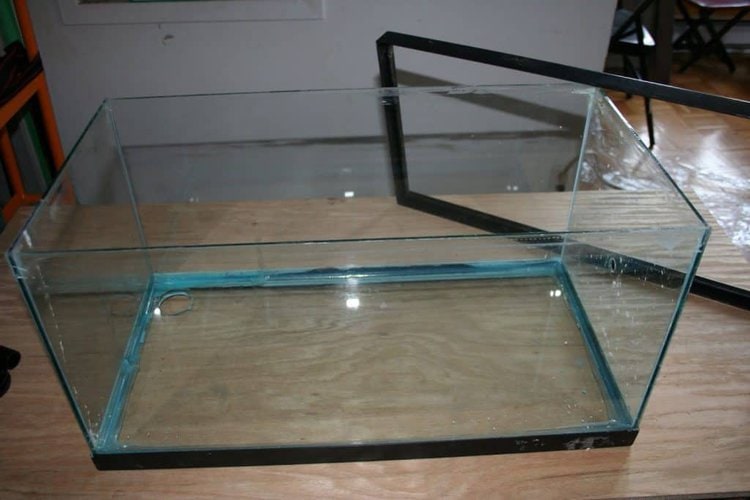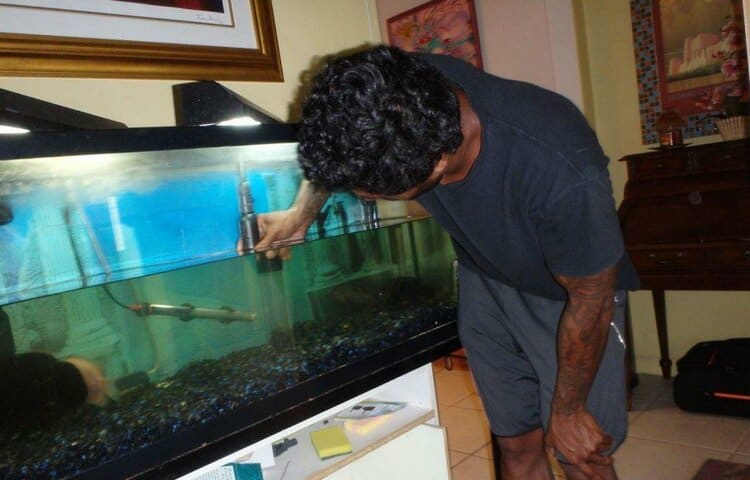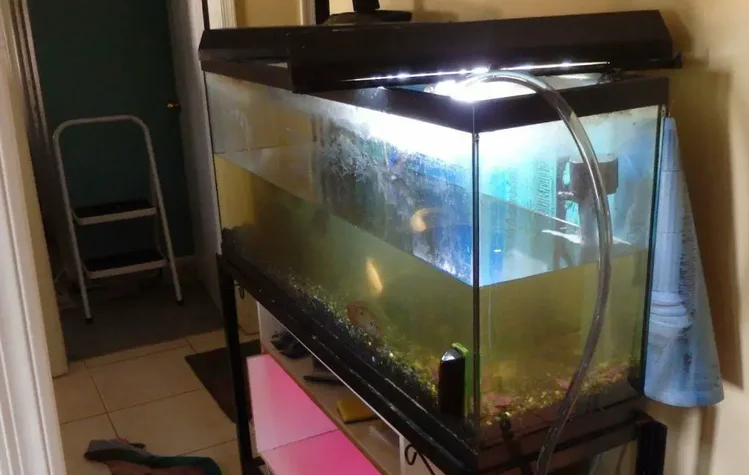To clean white residue from your aquarium glass, place your fish in a temporary bowl or tank. Take out all of the water, plants, or accessories inside the tank. Wipe sulfuric acid on the area with white residue and give it around 10-20 minutes. Wipe it down after this with a paper towel until the spots are gone.

Most fishkeepers use hard water to create a comfortable environment for their fish so they stay healthy and thrive in their tank. However, the drawback to using hard water is that the glass of your tank will require constant cleaning to keep it transparent.
When hard water dries up in a freshwater aquarium, it creates a white residue on the exterior surface of the glass. The white residue is a tell-tale sign of calcium buildup, known as limescale.
If you own an aquarium with salt water in it, the accumulation of salt residue in the form of white spots is also an issue.
It is important to note that the white residue left by calcium buildup is not toxic, so it cannot pose a threat to your fish. But you will not be able to see them in their aquarium, which is a sight for sore eyes and is not something you want to look at every day at home.
In this article, I will teach you the best method you can use to clean the white residue off the glass of your aquarium. There are many to choose from, but most are not 100% effective.
Removing Lime Buildup From Glass
Removing calcium buildup is not as hard as you might think if you can grasp the concept of how it works on a chemical level. The pH scale is very helpful with this task. It ranges from 1 to 14, with 7 being in the middle and known as neutral pH.
Any substance with a pH scale of 1 is highly acidic, and those with a pH level of 14 are alkaline.
Calcium buildup has a high pH level, meaning that it is alkaline. This also lets you know that it is water-soluble when dissolved with an acid. To remove calcium buildup, you need an acid to evaporate it with.
I will recommend the 3 you can use and which one I think is the best.
The first option is sulfuric acid (pH level of 2.75. It is often labeled as pH down or pH decrease and is easy to find in most pet stores near the fish section.
The second and third options are cleaning vinegar (pH level of 2 to 2.5) and lemon juice (pH level of 2). I only recommend the latter 2 if you do not have any sulfuric acid in your home because it does the best job at removing white residue from your glass tank from my many years of experience using it.
What You Will Need
- Paper towels
- Sulfuric acid ( I recommend the Top Fin brand)
- Razor Blade (If sulfuric acid was not enough)
- Cleaning Vinegar or Lemon Juice (Use if sulfuric acid is not available)
- Extra Fishbowl or holding tank
Instructions
- Take your fish out of the aquarium you plan to clean and put them in a fish bowl or a holding tank.
- Remove all the water from your tank and wait until it is dry.
Extra Tip: You don’t need to worry about removing gravel if your tank has any as long as there is no way it can fall out. If you have any plants or decorations inside, take them out and place them somewhere secure.
- Pick up your tank and put paper towels under it.
- Pour sulfuric acid on the glass areas with white residue, and ensure you don’t miss any spots.
- Allow your tank to sit for 10 to 20 minutes while the acid does its job, then wipe the affected areas with a sponge.
Follow step #6 only if you cannot remove the white residue completely after the steps above.
- Take a razor blade to softly scrape away the remaining residue from the glass surface.
Extra Tip: Do not use it on corners because it will tear up the silicone and cause leakages. Lastly, stay clear of this step if your tank is plexiglass. They scratch easily, and the razor blade will cause permanent damage.
Alternative Methods to Clean Aquarium Glass White Residue

1. Using Sponge & Rock Salt Method
The first method will only help you if the white residue is still fresh and has not been there for over a two-week period. All you will need to find is some rock salt and a small foam sponge.
Keep in mind that you cannot use fine grain salt and it should be equivalent to the size of rock salt crystals.
What You’ll Need
- Foam Sponge
- Rock Salt
Instructions
- Dip your entire foam sponge in a bowl of water for at least 10 to 20 seconds.
- Take the sponge out of the water and sprinkle a moderate amount of salt on it.
- Rub the area of the sponge with salt on it on the glass of your fish tank.
- Once the salt disappears, add some more to the sponge and repeat the process until you can no longer see any residue.
2. Sandpaper Method
This method is more traditional but still works well. You will surprise your friends and family when they see how effective it can be if you try it.
If using a razor does not work, then this will be your next option. Not to mention, the razor will soften the calcium buildup, so it will make using the sandpaper easier.
What You’ll Need
- Scissors
- 1000 Grit sandpaper
Instructions
- Cut and shape the sandpaper into little squares you can use.
- Scrub the area of your aquarium with white residue softly in a circular motion. The glass should start to clear up while you are doing this.
- Once the piece of sandpaper is worn out, grab a new square and keep going.
3. Pumice Stone Method
This method is the least popular but it is worth a shot if you want to try something different. Pumice stones are useful when it comes to rubbing dirt and calcium build up from glass tanks.
What You’ll Need
- Vinegar
- Pumice Stone
Instructions
- Apply a generous amount of vinegar to the affected area.
- Put the pumice stone in water for a second to make it wet.
- Scrub every part of the glass where you see white residue
Preventing Lime Build Up
As the old saying goes, “An ounce of prevention is worth a pound of cure,” which holds true when it comes to avoiding lime buildup in your tank.
I would recommend inspecting your aquarium’s water line every two days or so. This will help you avert water evaporation. Sunny days with warm weather and cold temperatures with low humidity are two culprits responsible for water evaporation in your tank.
The best way to add new water if you don’t want to clean out the whole tank is by using distilled water.
- Pour it in until it reaches the top again.
- When your water begins to evaporate, whatever is left feels thicker because there is a higher mineral to water ratio.
It makes sense that if the lost water was pure, the water to follow its replacement would also be refined.

Benefits of Distilled Water
Distilled water does not have any minerals. So if you replace the dried-up water with water that has added minerals, it puts your fish at risk. Distilled water solves this problem and keeps your fish safe.
On the other hand, if you are adjusting only some of the water in your fish tank, I suggest using the original hard water source to stay consistent.
The composition of minerals in the water will not change, keeping pH levels stable.
Avoiding a creeping level of acidification (when the pH drops) is preferable.
If you don’t have one already, invest in a water test kit that lets you know your aquarium’s pH hardness and alkalinity levels. These are the kind of preventative steps that will save you money and improve the quality of life of your beloved fish.
FAQs on How to Clean Aquarium Glass White Residue
Will Vinegar Hurt Aquarium Fish?
No, vinegar is a non toxic solution that will not harm your fish. It is often used as an option to cure various diseases that fish contract.
Can You Keep a Fish tank Clean without replacing the Water?
Yes, you can do this by using a filter. A filter helps purify the water by extracting all the dirt and necessary waste that keep the fish from living in a clean environment.